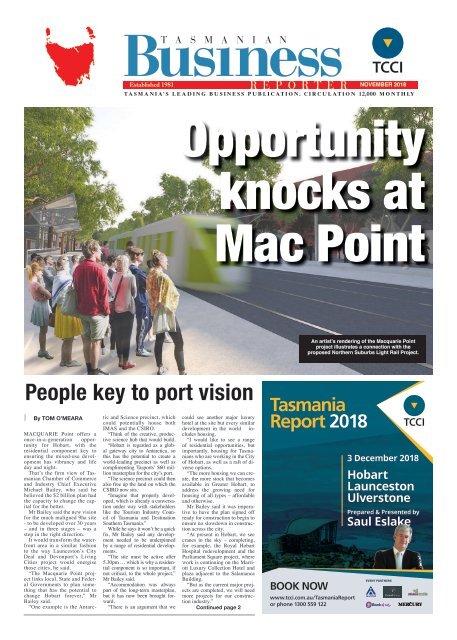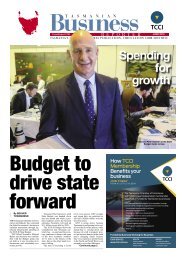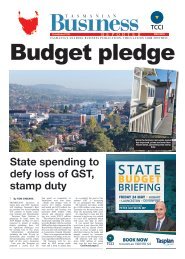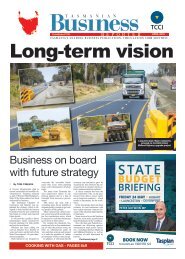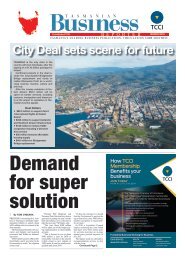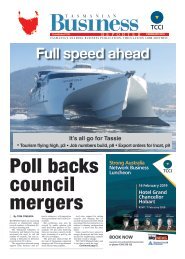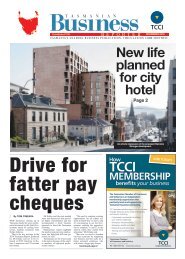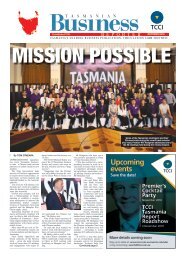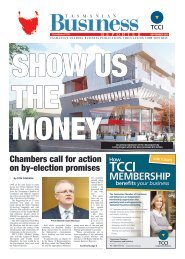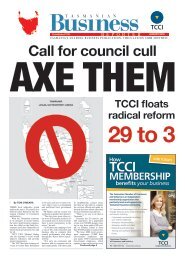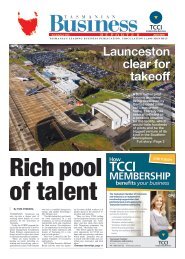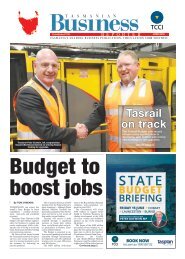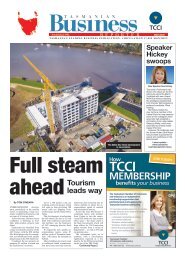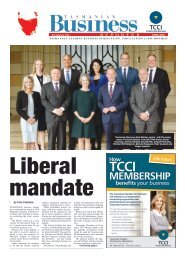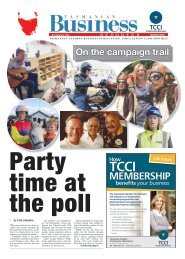Tasmanian Business Reporter November 2018
Welcome to the November edition of the Tasmanian Business Reporter. In this month's edition you'll read about the new vision for Macquarie Point, which TCCI CEO Michael Bailey believes is a once-in-a-generation opportunity for Tasmania if planned correctly and underpinned by residential development. You will also find details about a new Hobart fashion festival and strong profits from Tasmania’s two financial institutions, as well as some poignant HR tips for employers about how to handle the upcoming 'silly season' from TCCI Workplace Relations Consultant Abbey George.
Welcome to the November edition of the Tasmanian Business Reporter.
In this month's edition you'll read about the new vision for Macquarie Point, which TCCI CEO Michael Bailey believes is a once-in-a-generation opportunity for Tasmania if planned correctly and underpinned by residential development.
You will also find details about a new Hobart fashion festival and strong profits from Tasmania’s two financial institutions, as well as some poignant HR tips for employers about how to handle the upcoming 'silly season' from TCCI Workplace Relations Consultant Abbey George.
You also want an ePaper? Increase the reach of your titles
YUMPU automatically turns print PDFs into web optimized ePapers that Google loves.
NOVEMBER <strong>2018</strong><br />
T A S M A N I A’ S L E A D I N G B U S I N E S S P U B L I C A T I O N . C I R C U L A T I O N 12,000 M O N T H LY<br />
Opportunity<br />
knocks at<br />
Mac Point<br />
An artist’s rendering of the Macquarie Point<br />
project illustrates a connection with the<br />
proposed Northern Suburbs Light Rail Project.<br />
People key to port vision<br />
By TOM O’MEARA<br />
MACQUARIE Point offers a<br />
once-in-a-generation opportunity<br />
for Hobart, with the<br />
residential component key to<br />
ensuring the mixed-use development<br />
has vibrancy and life<br />
day and night.<br />
That’s the firm view of <strong>Tasmanian</strong><br />
Chamber of Commerce<br />
and Industry Chief Executive<br />
Michael Bailey, who said he<br />
believed the $2 billion plan had<br />
the capacity to change the capital<br />
for the better.<br />
Mr Bailey said the new vision<br />
for the much maligned 9ha site<br />
- to be developed over 30 years<br />
– and in three stages – was a<br />
step in the right direction.<br />
It would transform the waterfront<br />
area in a similar fashion<br />
to the way Launceston’s City<br />
Deal and Devonport’s Living<br />
Cities project would energise<br />
those cities, he said.<br />
“The Macquarie Point project<br />
links local, State and Federal<br />
Governments to plan something<br />
that has the potential to<br />
change Hobart forever,” Mr<br />
Bailey said.<br />
“One example is the Antarctic<br />
and Science precinct, which<br />
could potentially house both<br />
IMAS and the CSIRO.<br />
“Think of the creative, productive<br />
science hub that would build.<br />
“Hobart is regarded as a global<br />
gateway city to Antarctica, so<br />
this has the potential to create a<br />
world-leading precinct as well as<br />
complimenting Tasports’ $60 million<br />
masterplan for the city’s port.<br />
“The science precinct could then<br />
also free up the land on which the<br />
CSIRO now sits.<br />
“Imagine that properly developed,<br />
which is already a conversation<br />
under way with stakeholders<br />
like the Tourism Industry Council<br />
of Tasmania and Destination<br />
Southern Tasmania.”<br />
While he says it won’t be a quick<br />
fix, Mr Bailey said any development<br />
needed to be underpinned<br />
by a range of residential developments.<br />
“The site must be active after<br />
5.30pm … which is why a residential<br />
component is so important, if<br />
not critical, to the whole project,”<br />
Mr Bailey said.<br />
“Accommodation was always<br />
part of the long-term masterplan,<br />
but it has now been brought forward.<br />
“There is an argument that we<br />
could see another major luxury<br />
hotel at the site but every similar<br />
development in the world includes<br />
housing.<br />
“I would like to see a range<br />
of residential opportunities, but<br />
importantly, housing for <strong>Tasmanian</strong>s<br />
who are working in the City<br />
of Hobart, as well as a raft of diverse<br />
options.<br />
“The more housing we can create,<br />
the more stock that becomes<br />
available in Greater Hobart, to<br />
address the growing need for<br />
housing of all types – affordable<br />
and otherwise.<br />
Mr Bailey said it was imperative<br />
to have the plan signed off<br />
ready for construction to begin to<br />
ensure no slowdown in construction<br />
across the city.<br />
“At present in Hobart, we see<br />
cranes in the sky – completing,<br />
for example, the Royal Hobart<br />
Hospital redevelopment and the<br />
Parliament Square project, where<br />
work is continuing on the Marriott<br />
Luxury Collection Hotel and<br />
plaza adjacent to the Salamanca<br />
Building.<br />
“But as the current major projects<br />
are completed, we will need<br />
more projects for our construction<br />
industry.”<br />
Continued page 2<br />
Tasmania<br />
Report <strong>2018</strong><br />
BOOK NOW<br />
www.tcci.com.au/TasmaniaReport<br />
or phone 1300 559 122<br />
3 December <strong>2018</strong><br />
Hobart<br />
Launceston<br />
Ulverstone<br />
Prepared & Presented by<br />
Saul Eslake<br />
EVENT PARTNERS
T A S M A N I A’ S L E A D I N G B U S I N E S S P U B L I C A T I O N . C I R C U L A T I O N 12,000 M O N T H LY<br />
2 <strong>Tasmanian</strong> <strong>Business</strong> <strong>Reporter</strong> - NOVEMBER <strong>2018</strong><br />
NEWS<br />
New super<br />
life cover<br />
partnership<br />
TASMANIAN industry<br />
super fund Tasplan has<br />
announced a new partnership<br />
with leading<br />
life insurance provider<br />
MetLife to deliver innovative<br />
and affordable<br />
insurance offerings.<br />
Tasplan Chief Operations<br />
Officer Nick Connor<br />
said the partnership<br />
with MetLife would<br />
give members a strong<br />
offering to help them<br />
navigate the changing<br />
landscape of insurance<br />
inside super.<br />
“Tasplan is committed<br />
to delivering excellent<br />
customer service<br />
and returns for our<br />
members and MetLife<br />
demonstrated its ability<br />
to form a unique partnership<br />
that aligns with<br />
our values and addresses<br />
the specific needs of<br />
the fund,” Mr Connor<br />
said.<br />
“We know the proposed<br />
federal budget<br />
changes to insurance inside<br />
super adds another<br />
level of complexity and<br />
uncertainty and we identified<br />
the need to partner<br />
with an organisation<br />
that can respond to these<br />
changes and evolve with<br />
us and our members.<br />
“We understand the value<br />
of insurance in superannuation<br />
and the<br />
importance of default<br />
insurance which offers<br />
our members value<br />
for money protection.<br />
“The member experience<br />
is critically important<br />
to Tasplan and<br />
the ability to offer digital<br />
solutions that make<br />
the process of both applying<br />
and claiming fast<br />
and easy, was also high<br />
on our priority list.”<br />
MetLife will be working<br />
with Tasplan over<br />
the transition period to<br />
identify the best way<br />
forward, taking into<br />
consideration the expected<br />
budget changes,<br />
in order to deliver the<br />
best possible product<br />
design for its members.<br />
The new insurance<br />
product will be ready to<br />
go live on July 1, 2019.<br />
Challenge of an ageing workforce<br />
TASMANIA’S work<br />
health, safety and<br />
wellbeing professionals<br />
addressed the future<br />
challenges presented by<br />
changing work patterns<br />
and operating environments<br />
at the <strong>2018</strong><br />
WorkSafe Conference<br />
last month.<br />
From an ageing workforce<br />
to the ever-extending<br />
reach of new technologies,<br />
staying ahead<br />
of these challenges was<br />
deemed vital for the<br />
health and wellbeing of<br />
all <strong>Tasmanian</strong> workers.<br />
University of Melbourne<br />
Professor of<br />
Management Peter<br />
Gahan presented at the<br />
conference about ageism<br />
– the phenomena of<br />
age-based prejudice and<br />
discrimination, focussing<br />
on how organisations<br />
can minimise age-based<br />
stereotyping to ensure an<br />
inclusive work environment.<br />
Prof. Gahan said as the<br />
population aged across<br />
the world, ageism was<br />
becoming a growing<br />
problem, especially in<br />
the workplace.<br />
“Ageism is the idea<br />
that people are being<br />
University of Melbourne Professor of Management Peter Gahan<br />
presenting at the <strong>2018</strong> WorkSafe Conference at the Grand Chancellor in<br />
Hobart.<br />
assessed not so much for<br />
attributes, their skills, or<br />
their talents, but simply<br />
because of their age,”<br />
Prof. Gahan said.<br />
“That can happen for<br />
older people, but also<br />
younger people.<br />
“Generally older<br />
people are viewed as<br />
being warm and good at<br />
relationships, relatively<br />
stable and reliable, but<br />
incompetent – not being<br />
good at picking up new<br />
skills, understanding<br />
new technologies, being<br />
able to adapt or be<br />
flexible.<br />
“The evidence undertaken<br />
over the last 25<br />
years or so shows that<br />
most of those stereotypes<br />
are not true.”<br />
The <strong>2018</strong> WorkSafe<br />
Conference was part<br />
of WorkSafe Tasmania<br />
Month, aligning with<br />
the theme of “Future<br />
Work, Future Challenges”<br />
which aimed to<br />
raise awareness of the<br />
new health and safety<br />
issues arising as workplaces<br />
adapt to shifting<br />
external and internal<br />
conditions.<br />
Since 1996, when<br />
WorkSafe Month was<br />
first launched, the number<br />
of <strong>Tasmanian</strong>s who<br />
suffered work-related<br />
injuries or illnesses has<br />
more than halved, from<br />
16,167 to 6,941 in 2017.<br />
T A S M A N I A’ S L E A D I N G B U S I N E S S P U B L I C A T I O N . C I R C U L A T I O N 1 2 , 0 0 0 M O N T H LY<br />
e dition<br />
<strong>Tasmanian</strong> <strong>Business</strong> <strong>Reporter</strong> can now be delivered directly to your inbox. With our 30,000-strong monthly print<br />
readership, our new up-to-date digital distribution will keep <strong>Tasmanian</strong>s abreast of the all latest in local business<br />
news. From this month we will distribute electronic editions of the <strong>Tasmanian</strong> <strong>Business</strong> <strong>Reporter</strong> as we go to print.<br />
To confirm your copy sign up to our mailing list via<br />
tbreditorial@fontpr.com.au<br />
T A S M A N I A’ S L E A D I N G B U S I N E S S P U B L I C A T I O N . C I R C U L A T I O N 12,000 M O N T H LY<br />
Tasmania’s business newspaper is published monthly by the<br />
<strong>Tasmanian</strong> Chamber of Commerce and Industry. It is distributed<br />
to businesses in Tasmania as well as key decision-makers.<br />
Circulation: 12,000<br />
BUSINESS<br />
Managing Editor: Tom 2O’Meara<br />
0418 135 822<br />
Editor: Becher Townshend<br />
0418 370 661<br />
Advertising and Special Projects<br />
Gil Sellars 0448 901 371<br />
gil@thetrustedmediaco.com<br />
HOBART’S Editorial BEST & Advertising RANGE OF<br />
TBReditorial@fontpr.com.au<br />
FOR THE www.tasmanianbusinessreporter.com.au<br />
HOME AND OFFICE<br />
Publisher:<br />
We specialise <strong>Tasmanian</strong> in high Chamber quality ergonomic of Commerce chairs, and Industry<br />
alternative seating<br />
309 Liverpool<br />
and electronic<br />
St, Hobart,<br />
sit/stand<br />
TAS<br />
desks.<br />
7000<br />
Flair Ph: Office 6236 Furniture 3600 has Fax: been 6231 providing 1278 quality, admin@tcci.com.au<br />
affordable office<br />
furniture to homes and offices throughout the Hobart region<br />
for nearly 15 The years. Old We’re Post a locally-based, Office, 68-72 family-run Cameron business St,<br />
specialising in all types of Launceston products, so why TAS not 7250 visit us today to<br />
see our fantastic Ph: range? 6331 1144 laun@tcci.com.au<br />
Production:<br />
Phone 6234 1127<br />
aldridge.media<br />
260 Argyle Street,<br />
Ph: 0431 241 775<br />
North Hobart<br />
aldridge.media@iinet.net.au<br />
Printer: Mercury<br />
www.flairofficefurniture.com.au<br />
Level 1, 2 Salamanca Square, Hobart, 7000<br />
Opportunity knocks at Mac Point<br />
From page 1<br />
The new Masterplan<br />
includes many elements<br />
of the 2016 MONA Vision,<br />
as well as provision<br />
for the Northern<br />
Suburbs Light Rail project.<br />
Mr Bailey said it was<br />
vitally important that we<br />
properly celebrate our<br />
Aboriginal history within<br />
the development.<br />
“What I am also<br />
pleased to see is the retention<br />
of large areas of<br />
open space for everyone<br />
to enjoy,” he said.<br />
BUSINESS<br />
YOUR QUICK GUIDE TO SERVICES AND PRODUCTS FOR YOUR BUSINESS<br />
QUALITY ERGONOMIC FURNITURE<br />
The Macquarie Point<br />
project is planned as<br />
a “people place”..<br />
WANTED<br />
<strong>Business</strong><br />
movers and<br />
shakers<br />
• Promotions<br />
• Appointments<br />
• Awards<br />
• Celebrating<br />
success<br />
Share the news<br />
with the<br />
<strong>Tasmanian</strong><br />
business<br />
community<br />
Send your news<br />
snippets, with a<br />
high quality photo,<br />
to TBReditorial@<br />
fontpr.com.au<br />
To see your business here, call Kerri on 0419 750 267 or email kerri@thetrustedmediaco.com<br />
Your Partner<br />
in Print.<br />
www.footandplaysted.com.au<br />
Now incorporating<br />
THE CRAFT LIVES ON.
T A S M A N I A’ S L E A D I N G B U S I N E S S P U B L I C A T I O N . C I R C U L A T I O N 12,000 M O N T H LY<br />
Year of growth for MyState, Bank of us<br />
<strong>Tasmanian</strong> <strong>Business</strong> <strong>Reporter</strong> - NOVEMBER <strong>2018</strong> 3<br />
NEWS<br />
Home grown banks’ profits up<br />
TASMANIA’S two financial<br />
institutions have<br />
reported a successful<br />
year on the books, with<br />
MyState and Bank of us<br />
releasing their figures for<br />
the past financial year.<br />
Bank of us recorded an<br />
underlying profit before<br />
tax of $3.84m up 22 per<br />
cent, it says was due to<br />
increased revenue from<br />
strong loan book growth.<br />
Chairman Stephen<br />
Brown said an after-tax<br />
profit of $1.6m for the<br />
year was lower than the<br />
previous year due to the<br />
one-off costs associated<br />
with transitioning from<br />
B&E to Bank of us and<br />
the benefit from a substantial<br />
one-off profit on<br />
the sale of commercial<br />
property assets last year.<br />
Mr Brown said Bank of<br />
us’s loan portfolio grew<br />
12 per cent to $703m<br />
while loan approvals shot<br />
up by 27 per cent to a record<br />
$215m.<br />
Meanwhile, MyState<br />
Limited reported a net<br />
profit after tax of $31.5<br />
million for the year up<br />
4.6 per cent on the year<br />
before.<br />
MyState chairman<br />
Miles Hampton and managing<br />
director Melos<br />
My State managing<br />
director Melos Sulicich<br />
Sulicich said the strong<br />
result was supported by<br />
benefits from its investment<br />
in digitisation which<br />
Model Kate Loader shows off an item from emerging designer Sarah Boyadjian.<br />
Bank of us chairman<br />
Stephen Brown<br />
have improved services<br />
for customers, as well as<br />
by productivity gains and<br />
cost management.<br />
Speaking at the company’s<br />
<strong>2018</strong> annual general<br />
meeting, Mr Hampton and<br />
Mr Sulicich again called<br />
for the Federal Government<br />
and regulators to<br />
take positive action to level<br />
the playing field.<br />
Mr Hampton said regulation<br />
tightening bank<br />
lending had favoured the<br />
growth of the shadow<br />
banking sector, with a<br />
recent estimate suggesting<br />
it already had 7 per<br />
cent market share and<br />
that figure was thought<br />
to be growing at four to<br />
five times the rate of bank<br />
lending.<br />
Local fashionistas hit catwalk<br />
MOVE over New York and London,<br />
Hobart will welcome a new festival in<br />
<strong>November</strong> full of fashion, design, insights<br />
and inspiration from emerging, current and<br />
expat <strong>Tasmanian</strong> designers.<br />
The Hobart region has seen a growth of<br />
creative industries and events over recent<br />
years, and now is the time for the local fashion<br />
industry to put its foot forward into the<br />
spotlight - with Hobart Fashion Week to run<br />
from <strong>November</strong> 20th to 25th.<br />
Event Director, Nikola Colls said the<br />
event would become a standout “not only<br />
for its showcase of design, but for our ability<br />
to connect various communities into the<br />
world of fashion and art, with an emphasis<br />
on place and ideas”.<br />
HFW will exhibit Tasmania’s creative talent<br />
in fashion and design, providing inclusive<br />
and engaging workshops, exhibitions<br />
and local business events, complementing<br />
the featured runways to share insight into<br />
the world behind what you wear.<br />
The event supporters, City Mission Op<br />
Shops, City of Hobart and Orenda Studios,<br />
have helped develop a program of events,<br />
which fosters creative innovation, inclusive<br />
community engagement, and sustainable<br />
opportunities.<br />
Mr Sulicich welcomed<br />
the Productivity Commission’s<br />
finding that<br />
the larger banks gained<br />
an unfair funding advantage<br />
from their “too big<br />
to fail” status, combined<br />
with capital benefit from<br />
advanced accreditation.<br />
“While regulations require<br />
all banks to hold<br />
capital against loans,<br />
smaller banks hold 56<br />
per cent more capital<br />
than larger banks even<br />
though the risk of issuing<br />
mortgages is the<br />
same.<br />
Consumers are demanding<br />
the competition<br />
Picture: Samantha Christian<br />
that smaller banks provide,<br />
but we are hobbled<br />
by capital constraints<br />
which let larger banks<br />
lend much more with the<br />
same capital.<br />
“We urge the government<br />
to increase the average<br />
mortgage risk weights<br />
which govern larger<br />
banks’ reserves to reduce<br />
their lending advantage,”<br />
he said.<br />
“Although our result<br />
shows we are well placed<br />
to adapt to competitive<br />
challenges, we believe we<br />
are unfairly constrained<br />
by regulations that benefit<br />
larger banks.”<br />
Visitors<br />
keen to<br />
pedal<br />
AN Australian-first program<br />
that helps local<br />
businesses benefit from<br />
the popularity of cycle<br />
tourism is about to gain<br />
more traction.<br />
The Tourism Industry<br />
Council Tasmania released<br />
the nation’s first<br />
Bike Friendly <strong>Business</strong><br />
Accreditation Program<br />
last year, to inform cycling<br />
tourists where to<br />
shop, stay and visit, and<br />
help promote the state as<br />
being cycling friendly.<br />
The program is free<br />
for tourism-accredited<br />
businesses and TICT<br />
will provide training and<br />
resources to assist with<br />
gaining accreditation.<br />
About 38,000 visitors<br />
jump on a bike during<br />
their visit to Tasmania.<br />
The Government contributed<br />
$85,000 to the<br />
development of the program<br />
as part of its $6<br />
million Cycle Tourism<br />
Strategy.<br />
WANTED<br />
<strong>Business</strong><br />
movers and<br />
shakers<br />
• Promotions<br />
• Appointments<br />
• Awards<br />
• Celebrating<br />
success<br />
Share the news<br />
with the<br />
<strong>Tasmanian</strong><br />
business<br />
community<br />
Send your news<br />
snippets, with a<br />
high quality photo,<br />
to TBReditorial@<br />
fontpr.com.au
4 <strong>Tasmanian</strong> <strong>Business</strong> <strong>Reporter</strong> - NOVEMBER <strong>2018</strong><br />
THOUGHT LEADERSHIP<br />
North West Coast<br />
underpins economy<br />
Paul<br />
Arnold<br />
TCCI Vice Chairman<br />
THE <strong>Tasmanian</strong> Economy<br />
has enjoyed a sustained<br />
period of positivity.<br />
The North-West economy<br />
has suffered its fair<br />
share of knocks over the<br />
past decade but continues<br />
to show its amazing resilience.<br />
International commodity<br />
pricing has taken its<br />
toll on mining and agricultural<br />
returns over the<br />
past decade, but as we<br />
head for 2019, we are<br />
again on the cusp of very<br />
bright economic times.<br />
Our significant competitive<br />
advantages include:<br />
• quality of the minerals<br />
in our ground;<br />
• quality of our food<br />
production systems, particularly<br />
our rich soils;<br />
• our depth of industry<br />
sectors, from aquaculture,<br />
forestry, tourism,<br />
cropping, beef and dairy;<br />
• the innovation of our<br />
advanced manufacturing<br />
sector; and<br />
• the strength of our<br />
communities and their<br />
resultant workforce –<br />
and the list goes on.<br />
The North West does<br />
some heavy lifting for<br />
our State Domestic Product,<br />
as most of our contribution<br />
comes from primary<br />
industry.<br />
It has often been said<br />
that if we cut off the<br />
North West 64 telephone<br />
district, the rest of Tasmania’s<br />
living standards<br />
would drop sharply.<br />
Most of our sectors<br />
abound with confidence<br />
and the future is very<br />
bright indeed.<br />
Each area that we<br />
think about, from mining<br />
start-ups or re-starts,<br />
manufacturing, dairying,<br />
beef, cropping, aquaculture,<br />
tourism, and wind<br />
farms, all share one thing<br />
in common – the need for<br />
a more available and engaged<br />
workforce.<br />
Every sector will be<br />
crying out for hundreds<br />
of new employees in<br />
just a few short years,<br />
and our biggest threat<br />
is that we are ill prepared<br />
for what is coming.<br />
Our population will<br />
prove inadequate for the<br />
jobs that are available,<br />
our people will be insufficiently<br />
trained for the<br />
plethora of jobs coming,<br />
and our towns will not<br />
have sufficient housing<br />
for what is on the horizon.<br />
One might say these<br />
are good problems to<br />
have, but the corollary<br />
of that is that opportunities<br />
will be lost forever.<br />
What is needed shortterm<br />
is a serious plan to<br />
address all of the training<br />
and skills deficits,<br />
lack of people and engaged<br />
political leadership.<br />
The TCCI has been<br />
focussing on a range of<br />
high-level strategic issues<br />
impacting Tasmania.<br />
The annual Tasmania<br />
Report is a signature<br />
document that provides a<br />
clear focus on what is improving,<br />
what is lacking<br />
and options to improve<br />
our collective future.<br />
The next edition is imminent.<br />
The TCCI Board is<br />
currently focussed on<br />
five key priorities for<br />
the <strong>Tasmanian</strong> Economy,<br />
for the short-term,<br />
medium-term and longer-term.<br />
Once determined,<br />
these will become key<br />
pillars of advocacy in<br />
coming months.<br />
We welcome your input.<br />
Paul Arnold is TCCI<br />
North West Director.<br />
www.tcci.com.au<br />
Associate degrees<br />
offer career growth<br />
LeeWhiteley<br />
University College<br />
Chief Executive<br />
WHEN developing<br />
the range of University<br />
College associate<br />
degrees, one of our<br />
objectives was to provide<br />
opportunities for<br />
people already in the<br />
workforce to up-skill<br />
and gain a formal qualification.<br />
We have been able<br />
to achieve this by providing<br />
students with<br />
practical and relevant<br />
study experiences,<br />
with the ability to undertake<br />
subject assessment<br />
in the workplace.<br />
In doing so, students<br />
have been able<br />
to apply their learning<br />
directly to the workplace<br />
while they study,<br />
allowing them to put<br />
what they have studied<br />
into practice right<br />
away.<br />
This has enormous<br />
benefit both for the<br />
student and the employer.<br />
As such, we have<br />
found that many businesses<br />
from different<br />
sectors have come to<br />
us looking for opportunities<br />
to support<br />
their staff into study.<br />
One such example<br />
of this is our student,<br />
James Johnston, who<br />
is studying our Supply<br />
Chain Management<br />
specialisation<br />
and currently working<br />
full time as a Storeman<br />
at the Kingborough<br />
Council.<br />
James has been supported<br />
by his workplace<br />
throughout his<br />
studies, as his manager<br />
is able to appreciate<br />
the long-term benefit<br />
for the Council.<br />
The flexible delivery<br />
of the course has<br />
also made it possible<br />
for James to continue<br />
working full time<br />
while completing his<br />
studies.<br />
Another way that<br />
we have been able to<br />
ensure our associate<br />
degrees are relevant to<br />
those in the workforce<br />
is through regular engagement<br />
with industry.<br />
We do this by developing<br />
our courses<br />
with industry experts<br />
and actively involving<br />
them in the course delivery.<br />
This is done in a<br />
range of ways including<br />
workshops, industry<br />
placements and real-world<br />
case studies.<br />
With applications<br />
open for 2019, now<br />
is the time to get in<br />
touch with our team<br />
to talk about study<br />
options for you or<br />
your staff. Visit utas.<br />
edu.au/college, call<br />
us on 1300 363 864 or<br />
email us on Course.<br />
Info@utas.edu.au.<br />
Time for a<br />
cover review?<br />
Just ask us!<br />
With so many options, reviewing your<br />
cover with St.LukesHealth is easy!<br />
SPECIAL<br />
OFFER<br />
Join or Switch to<br />
Hospital and Extras and<br />
we’ll waive the 2, 3 and 6<br />
month waiting periods<br />
on extras cover. †<br />
Offer ends <strong>November</strong> 30, <strong>2018</strong>.<br />
Talk to our friendly, local team today.<br />
We can even come to you. It’s Easy!<br />
1300 651 988 stlukes.com.au<br />
for Customer Satisfaction*<br />
two years in a row!<br />
† Offer ends <strong>November</strong> 30, <strong>2018</strong>. Conditions apply, see website for details. Extras waiting periods greater than six months still apply. * #1 Roy Morgan Customer Satisfaction Awards: Private Health Insurer of the Year – 2016 & 2017. St.LukesHealth ABN 81 009 479 618 180619
<strong>Tasmanian</strong> <strong>Business</strong> <strong>Reporter</strong> - NOVEMBER <strong>2018</strong> 5<br />
THOUGHT LEADERSHIP<br />
www.tcci.com.au<br />
‘Accidental’ life in economics<br />
FORMER top public servant<br />
Donald Challen AM<br />
FAICD traces the beginning<br />
of his distinguished<br />
career in academia, the<br />
public service and in corporate<br />
governance back<br />
to what he calls “a bit of<br />
an accident, really”.<br />
When his initial postschool<br />
plans fell through,<br />
a friend nudged him towards<br />
economics at the<br />
University of Tasmania.<br />
“My father was a great<br />
believer in careful due<br />
diligence and he helped<br />
me find out a bit more<br />
about economics. It reinforced<br />
my thinking that<br />
it sounded worth having<br />
a crack at. So, I enrolled<br />
in economics at the university<br />
and – within a<br />
couple of months – it felt<br />
like someone had turned<br />
the lights on.”<br />
Challen believes that<br />
what he learned has had a<br />
far-reaching influence on<br />
his thinking throughout<br />
his career.<br />
“They say that economics<br />
changes your life<br />
– rewires your brain. I<br />
think that’s right. Economists<br />
do tend to think<br />
a bit differently from the<br />
rest of society. I was introduced<br />
to a series of<br />
concepts that really resonated<br />
with me – it’s been<br />
a part of my life ever<br />
since.”<br />
After graduating from<br />
the university with firstclass<br />
Honours and a<br />
Master of Economics,<br />
Challen was 15 years an<br />
academic economist.<br />
In 1980, he was instrumental<br />
in obtaining government<br />
funding for the<br />
Centre for Regional Economic<br />
Analysis (CREA)<br />
where he was Founding<br />
Director. He also served<br />
as Chair of CREA’s<br />
board for a decade from<br />
1993.<br />
After a two-year stint<br />
at the Office of the Economic<br />
Planning Advisory<br />
Council in Canberra,<br />
Challen returned to Tasmania<br />
in 1986 as Deputy<br />
Under-Treasurer at the<br />
<strong>Tasmanian</strong> Treasury.<br />
He was Managing Director<br />
of the <strong>Tasmanian</strong><br />
Development Authority<br />
for two years and then<br />
appointed Secretary of<br />
the Department of Treasury<br />
and Finance in 1993.<br />
He served as Secretary<br />
for 17 years, working<br />
with six Premiers and six<br />
<strong>Tasmanian</strong> Governor Kate Warner with Donald Challen.<br />
Treasurers of Liberal and<br />
Labor governments.<br />
While he was in the<br />
public sector, particularly<br />
throughout his stint<br />
as head of the Treasury,<br />
he was asked to serve on<br />
several boards, both private<br />
and government.<br />
Challen says, “That really<br />
whet my appetite for<br />
a career as a non-executive<br />
director…and what<br />
I’ve been able to do has<br />
been very rewarding. Initially,<br />
there were opportunities<br />
that were thrust<br />
on me, but it opened my<br />
eyes to the fascinating<br />
spectrum of activities<br />
that you can get involved<br />
in through a non-executive<br />
director role.”<br />
He is currently Chair<br />
of the Motor Accidents<br />
Insurance Board and<br />
is Deputy Chair of the<br />
board of the <strong>Tasmanian</strong><br />
Symphony Orchestra.<br />
In 2013 he was made a<br />
Member of the Order of<br />
Australia.<br />
Looking to the future<br />
of Australian corporate<br />
governance, Challen<br />
notes that driving an appropriate<br />
and positive organisational<br />
culture will<br />
be a particular challenge.<br />
“Cultures are exceedingly<br />
difficult to change,”<br />
he says. “We tend to forget<br />
that human beings<br />
respond to the incentives<br />
presented to them. If you<br />
see behavior that you<br />
don’t like in groups of<br />
people or in companies,<br />
the best way to cure it is<br />
to change the incentives<br />
for people. Regulation is<br />
a very blunt instrument.”<br />
Organisational culture<br />
has been brought into the<br />
spotlight by the Royal<br />
Commission into Misconduct<br />
in the Banking,<br />
Superannuation and Financial<br />
Services Industry.<br />
In his Interim Report,<br />
Commissioner Kenneth<br />
Hayne AC QC posed<br />
that further regulation<br />
would add “an extra<br />
layer of complexity” to<br />
an already complex regulatory<br />
regime. Challen<br />
agrees. “Individuals respond<br />
to incentives and<br />
the cultures of companies<br />
are the amalgam<br />
of the behaviours of the<br />
individuals working in<br />
them. Thus, in a fairly<br />
direct way, a company’s<br />
culture is the result of<br />
the incentives provided<br />
to its employees.”<br />
While Challen’s career<br />
path has veered to<br />
take him through such a<br />
variety of professional<br />
experiences, his changing<br />
roles allowed him<br />
the opportunity to contribute<br />
throughout the<br />
development of one of<br />
Tasmania’s largest infrastructure<br />
projects:<br />
the Basslink electricity<br />
connection.<br />
He was involved in<br />
the project’s conception<br />
as chair of the public<br />
service steering committee,<br />
and then sat on<br />
the Basslink Development<br />
Board, which<br />
found the private developer,<br />
National Grid<br />
PLC, to design, construct<br />
and operate the<br />
project.<br />
Later, as a member of<br />
the board of Hydro Tasmania,<br />
he had a hand in<br />
the negotiation of the<br />
contractual arrangements<br />
between Hydro Tasmania<br />
and National Grid, which<br />
were essential for the<br />
project to proceed.<br />
As Hydro Tasmania’s<br />
Battery of the Nation initiative<br />
investigates future<br />
expansion of Tasmania’s<br />
clean energy capacity,<br />
this piece of infrastructure<br />
could further embed<br />
Tasmania’s place in supporting<br />
energy supply to<br />
mainland Australia.<br />
Infrastructure<br />
surcharge angst<br />
INFRASTRUCTURE<br />
surcharges got the attention<br />
of everyone in<br />
Tasmania recently with<br />
the announcement of DP<br />
World pretty much doubling<br />
their fees at West<br />
Swanson terminal from<br />
January 2019.<br />
There is a lot of angst<br />
about this charge as there<br />
is no control or regulation<br />
as to what can be<br />
charged – it is set and issued<br />
and the fear is that<br />
once one charges it (or<br />
even increases it) they<br />
all will.<br />
It is a reasonable fear<br />
as this is has increased a<br />
number of times over the<br />
year and on the back of<br />
the Melbourne port levy,<br />
peak season charges<br />
for inward freight, toll<br />
charges, bio security<br />
surcharge additions and<br />
booking slot increases<br />
you could be forgiven<br />
for thinking that there is<br />
a lot of clipping of the<br />
ticket going on.<br />
Bringing it back to<br />
Tasmania, however, in<br />
relation to the infrastructure<br />
surcharges, it is important<br />
to understand<br />
how our freight is currently<br />
moving.<br />
Presently the majority<br />
of our exported and<br />
imported international<br />
cargo goes one of two<br />
Brett<br />
Charlton<br />
Agility Logistics<br />
ways – direct ex Bell Bay<br />
on the MSC vessel or via<br />
Melbourne with the trans<br />
bass carriers (Tolls or<br />
Searoad).<br />
In relation to MSC,<br />
the cargoes either do not<br />
touch Melbourne port or<br />
if they do, they are done<br />
within the port infrastructure<br />
– therefore there is<br />
no port infrastructure surcharge<br />
applied.<br />
In regards to the via<br />
Bass Strait cargoes, the<br />
infrastructure surcharge is<br />
billed to the line by their<br />
nominated cartage company<br />
and I am advised<br />
that presently this is being<br />
absorbed into the terrific<br />
revenue that the lines are<br />
making on the terminal<br />
handling charges (a story<br />
for another day).<br />
I will be keeping a close<br />
eye on this as it evolves,<br />
but <strong>Tasmanian</strong> exporters<br />
and importers need to review<br />
all options in their<br />
considerations – including<br />
where the cargo is received<br />
in Australian ports<br />
and the costs associated.<br />
The Brown Marmorated<br />
Stink Bug (BMSB)<br />
risk season is something<br />
that importers would<br />
have heard of if they are<br />
importing from those<br />
countries at risk.<br />
Importers are bearing<br />
costs for fumigation or<br />
heat treatment as well as<br />
facing delays in inspections,<br />
cost burdens of<br />
demurrage and detention<br />
and other costs as a result<br />
of the strict enforcement<br />
of the protocols for importation<br />
from countries<br />
affected by this creature.<br />
The issue is difficult<br />
because of our lack of<br />
infrastructure and the<br />
costs involved for treatment<br />
and the volume<br />
of cargo relevant to the<br />
BMSB risk – but please<br />
take some time to look<br />
up what is happening<br />
in Europe and America<br />
with this bug – it is an<br />
infestation of mammoth<br />
proportions and something<br />
we need to avoid<br />
coming to Australia at all<br />
costs.<br />
Australian<br />
Maritime<br />
College<br />
Providing the future<br />
leaders in the global<br />
maritime industry.<br />
Be part of the multi-billion dollar<br />
global logistics network with a<br />
Master of Logistics Management.<br />
Develop a core knowledge of international<br />
logistics management including business<br />
logistics, supply chain management, strategic<br />
procurement, warehousing and inventory<br />
management, eLogistics, eCommerce,<br />
logistics management, international trade,<br />
value chain innovation, and project management.<br />
Travel the globe with your qualification from AMC.<br />
> Enquire now at amc.edu.au<br />
CRICOS Provider Code (University of Tasmania): 00586B
6 <strong>Tasmanian</strong> <strong>Business</strong> <strong>Reporter</strong> - NOVEMBER <strong>2018</strong><br />
THOUGHT LEADERSHIP<br />
Prevention best cure<br />
for state’s health woes<br />
Paul<br />
Lupo<br />
CEO, StLukesHealth<br />
TASMANIANS generally<br />
consider themselves<br />
to be in good health but<br />
when you look at the statistics,<br />
it tells a different<br />
story.<br />
ABS data shows that<br />
compared with the rest<br />
of Australia, Tasmania<br />
has higher rates of chronic<br />
disease like arthritis,<br />
asthma, heart disease and<br />
mental issues.<br />
It is a sobering reality<br />
check and leaves little<br />
wonder why our health<br />
system is under so much<br />
stress and why the need<br />
for private health insurance<br />
is so strong.<br />
At St.LukesHealth we<br />
believe it’s necessary<br />
to balance the immediate<br />
requirements for<br />
treating disease with a<br />
longer-term sustainable<br />
solution of preventing<br />
it, and its pleasing to see<br />
great work is being undertaken<br />
by another notfor-profit<br />
organisation in<br />
Tasmania, the Royal Flying<br />
Doctor Service.<br />
While the RFDS is<br />
known for its aeromedical<br />
service in transferring<br />
patients from remote<br />
places to hospital, its<br />
footprint on the ground in<br />
<strong>Tasmanian</strong> communities<br />
is quite large.<br />
The RFDS runs a Primary<br />
Healthcare program<br />
in Tasmania aimed at improving<br />
both the mental<br />
and physical health<br />
outcomes of those living<br />
with chronic health conditions.<br />
The service is<br />
delivered in remote and<br />
rural communities with<br />
a holistic approach to a<br />
person’s well-being.<br />
In a recent conversation<br />
with John Kirwan,<br />
CEO of the <strong>Tasmanian</strong><br />
RFDS, he mentioned<br />
that there was a significant<br />
correlation between<br />
physical health and mental<br />
health.<br />
“An example would<br />
be a middle-age woman<br />
with depression who is<br />
taking medication, but<br />
this medication causes<br />
her to put on weight,<br />
causing her to lose more<br />
self-confidence. Often<br />
our mental and physical<br />
health workers will work<br />
with the client at the<br />
same time to achieve the<br />
best possible result,” Mr<br />
Kirwan said.<br />
“We are focusing on<br />
hospital avoidance.”<br />
The service also runs<br />
a dental program that<br />
visits schools and community<br />
health centres<br />
allowing those who cannot<br />
visit regional centres<br />
with the opportunity to<br />
receive treatment.<br />
The demand has been<br />
significant, with the<br />
RFDS’ two dental teams<br />
delivering more than<br />
1500 treatments to 1200<br />
patients on the North<br />
West Coast in the past 18<br />
months.<br />
“A lot of it is access,<br />
they will have a visiting<br />
service but for a lot of<br />
people it is about money.<br />
Getting to a dental clinic<br />
is hard if both parents<br />
are working or if there<br />
are transport issues,” Mr<br />
Kirwan said.<br />
Dental disease is one<br />
of the largest preventable<br />
hospitalisations in<br />
Tasmania with the biggest<br />
cohort being young<br />
women and children.<br />
It is one reason why<br />
St.LukesHealth places<br />
so much emphasis on its<br />
RFDS dental assistant Taneesha Torlach.<br />
Gap Free Preventative<br />
Dental offer to its members.<br />
Mr Kirwan said dental<br />
disease should not<br />
result in hospitalisations<br />
because it is almost 100<br />
per cent preventable and<br />
if people were in hospital<br />
as a result, then they<br />
were taking up valuable<br />
room for other patients<br />
with non-preventable<br />
conditions.<br />
“Our focus in the (dental)<br />
program is on prevention<br />
and promotion<br />
and educating kids about<br />
looking after their teeth.<br />
If we can do that it stops<br />
some of the longer-term<br />
problems,” Mr Kirwan<br />
said.<br />
While primary care is<br />
not often seen as an exciting<br />
area of medicine,<br />
the focus needs to shift<br />
from treating disease to<br />
preventing it.<br />
Our focus must move<br />
towards prevention if<br />
we are to achieve better<br />
health outcomes for <strong>Tasmanian</strong>s.<br />
www.tcci.com.au<br />
Warning on<br />
water deal<br />
Scott<br />
Bacon<br />
Shadow Treasurer<br />
WHILE Labor reluctantly supported the water and<br />
sewerage changes in Parliament, it did so while<br />
sounding the warning that the key issues facing the<br />
sector remain, despite the ownership changes.<br />
At the last election, Labor proposed a way forward<br />
for three vital infrastructure projects – Macquarie<br />
Point, Launceston’s combined system and<br />
Cameron Bay (to allow for MONA stage 2) – by<br />
seeking investment from industry superannuation<br />
funds to break the water and sewerage deadlock in<br />
the state.<br />
With the election in the rear-view mirror and<br />
the Government’s changes passing Parliament, we<br />
would hope that by the next election due in 2022<br />
these projects will be well advanced, if not completed.<br />
We’re concerned that the deal provides not a single<br />
cent of new money for water and sewerage infrastructure,<br />
despite funnelling $200 million of taxpayers’<br />
money into the business.<br />
The information memorandum provided to owner<br />
councils by TasWater shows the business restricted<br />
by more debt, lower revenue and higher interest<br />
costs. Specifically, the deal:<br />
• does not provide a real cost decrease for TasWater<br />
customers;<br />
• provides no extra funding for water and sewerage<br />
infrastructure;<br />
• violates TasWater’s long-term financial plan,<br />
moving its interest cover ratio out of recommended<br />
parameters;<br />
• creates a governance nightmare with a complicated<br />
ownership structure and deadlock arrangements;<br />
• provides no dividend certainty for councils; and<br />
• erodes the independent role of the Economic<br />
Regulator.<br />
The deal delivers $200 million of taxpayers’ money<br />
into TasWater, but costs the company $236 million<br />
in lost revenue over the life of the deal.<br />
The water and sewerage industry is telling me that<br />
it desperately needs funding for new infrastructure.<br />
Countless independent reports reaffirm this.<br />
For all of the criticisms of TasWater over the past<br />
few years, it has already succeeded in having all<br />
boiled water alerts removed across the state.<br />
The challenge for TasWater will be to continue to<br />
operate with immunity from any political considerations<br />
from its new owners, the <strong>Tasmanian</strong> Government.<br />
Water and sewerage investment must be<br />
made on the basis of sound business cases and in the<br />
strategic interests of the <strong>Tasmanian</strong> economy.<br />
In-house invitation for safety system input<br />
A REQUIREMENT of<br />
the Workplace Health<br />
Act is to provide a safe<br />
system of work.<br />
To ensure that the Person<br />
Conducting a <strong>Business</strong><br />
or Undertaking<br />
(PCBU) is able to fill<br />
these requirements of the<br />
Act, it is imperative that<br />
a Workplace Health and<br />
Safety Management System<br />
(WHSMS) is developed<br />
for the workplace.<br />
You can have a system<br />
developed by an external<br />
consultant or develop it<br />
yourself.<br />
A system developed in<br />
house seems to work successfully<br />
as all the stake<br />
holders can have input<br />
ensuring commitment to<br />
the system.<br />
A WHSMS consists of<br />
Craig<br />
Hortle<br />
Workplace Health & Safety<br />
the following:<br />
• Policy – a simple<br />
statement that indicates<br />
your commitment to the<br />
activity;<br />
• Procedure – this<br />
states how you are going<br />
to implement the policies<br />
that you have decided on;<br />
You can have a system<br />
developed by an external<br />
consultant or develop it<br />
yourself.<br />
• Recording method –<br />
this how you record the<br />
information from your<br />
procedures.<br />
The policies that<br />
should be included in all<br />
WHSMS can be:<br />
• An overarching WHS<br />
policy;<br />
• An induction policy;<br />
• A safe system of<br />
work policy;<br />
• An incident management<br />
policy;<br />
• An emergency situation<br />
policy.<br />
Depending on the type<br />
of work your business<br />
undertakes and your<br />
workplace, there will be<br />
a number of other policies<br />
that you will have<br />
to implement to ensure<br />
compliance under the<br />
legislation.<br />
The areas out of the<br />
Act a WHSMS will help<br />
you comply in are as follows:<br />
3) Without limiting<br />
subsections (1) and (2),<br />
a person conducting a<br />
business or undertaking<br />
must ensure, so far as is<br />
reasonably practicable –<br />
(a) the provision and<br />
maintenance of a work<br />
environment without<br />
risks to health and safety;<br />
and<br />
(b) the provision and<br />
maintenance of safe<br />
plant and structures; and<br />
(c) the provision and<br />
maintenance of safe systems<br />
of work; and<br />
(d) the safe use, handling<br />
and storage of<br />
plant, structures and substances;<br />
and<br />
(e) the provision of<br />
adequate facilities for<br />
the welfare at work of<br />
workers in carrying out<br />
work for the business or<br />
undertaking, including<br />
ensuring access to those<br />
facilities; and<br />
(f) the provision of any<br />
information, training,<br />
instruction or supervision<br />
that is necessary to<br />
protect all persons from<br />
risks to their health and<br />
safety arising from work<br />
carried out as part of the<br />
conduct of the business<br />
or undertaking; and<br />
(g) that the health of<br />
workers and the conditions<br />
at the workplace<br />
are monitored for the<br />
purpose of preventing illness<br />
or injury of workers<br />
arising from the conduct<br />
of the business or undertaking.
<strong>Tasmanian</strong> <strong>Business</strong> <strong>Reporter</strong> - NOVEMBER <strong>2018</strong> 7<br />
THOUGHT LEADERSHIP<br />
www.tcci.com.au<br />
Strong interest in state energy projects<br />
Guy<br />
Barnett<br />
Minister for Energy<br />
THERE is a strong<br />
business interest in <strong>Tasmanian</strong><br />
energy projects,<br />
with our state’s business<br />
leaders recently gathering<br />
to discuss renewable<br />
energy projects at a<br />
range of forums hosted<br />
by the <strong>Tasmanian</strong>s<br />
Chamber of Commerce<br />
and Industry.<br />
The forums were<br />
focused on Battery of<br />
the Nation and Project<br />
Marinus, and how such<br />
projects can benefit <strong>Tasmanian</strong><br />
businesses and<br />
industries.<br />
Also being discussed<br />
were ways that businesses<br />
can prepare themselves<br />
to benefit from<br />
renewable energy sources<br />
and get involved with<br />
projects and contracts on<br />
the table.<br />
These forums high-<br />
light the interest in Tasmania’s<br />
energy future.<br />
We have what the rest<br />
of the country want –<br />
low cost, reliable, clean<br />
energy.<br />
The Government is<br />
working hard to improve<br />
the lives of <strong>Tasmanian</strong>s.<br />
We have an ambitious<br />
target of achieving the<br />
lowest regulated power<br />
prices in the country by<br />
2022, and becoming fully<br />
self-sufficient in the<br />
same timeframe.<br />
Our plans for further<br />
interconnection across<br />
Bass Strait, new pumped<br />
hydro schemes, significant<br />
upgrades to existing<br />
Hydro facilities and<br />
wind are also transformative<br />
opportunities for<br />
Tasmania that represent<br />
thousands of potential<br />
jobs.<br />
Foreign owners<br />
good business<br />
Sally<br />
Chandler<br />
Tradestart Adviser<br />
THE Department of Foreign<br />
Affairs and Trade<br />
has just published its report<br />
on the economic activity<br />
of foreign owned<br />
businesses in Australia<br />
during 2014-2015 and I<br />
quote directly from that<br />
report.<br />
One of the limitations<br />
with this report is that the<br />
reference year is already<br />
three years old. This is<br />
due to the time it takes<br />
for the Australian Bureau<br />
of Statistics (ABS) to get<br />
access to the detailed<br />
ATO <strong>Business</strong> Income<br />
Tax (BIT) database.<br />
The 2015-16 ATO BIT<br />
dataset will be delivered<br />
to the ABS in early 2019.<br />
The classification used<br />
to denote ‘foreign ownership’<br />
is those businesses<br />
with foreign ownership<br />
greater than 50 per<br />
cent equity.<br />
The research showed:-<br />
• In 2014-15, there<br />
were 9,946 majority foreign-owned<br />
operating<br />
businesses in Australia.<br />
• There were also<br />
1,208 Australian-owned<br />
companies with minority<br />
foreign ownership.<br />
• Foreign-owned businesses<br />
in Australia had<br />
assets valued at $1.9<br />
trillion in 2014-15, employed<br />
966,200 persons<br />
and paid wages and salaries<br />
valued at $67 billion.<br />
They made operating<br />
profits of $50 billion<br />
and contributed 11 per<br />
cent of total business tax<br />
revenue.<br />
• Foreign-owned businesses<br />
on average also<br />
paid higher wages and<br />
salaries than Australian-owned<br />
businesses<br />
and produced more output<br />
per employee.<br />
• These businesses<br />
contributed $222 billion<br />
in industry value added<br />
to the Australian business<br />
economy (excluding the<br />
Financial and Insurance<br />
Services industry which<br />
could not be measured),<br />
representing one fifth of<br />
total Australian business<br />
output.<br />
• These businesses recorded<br />
sales of goods<br />
and services of $770<br />
billion including an estimated<br />
$95 billion ex-<br />
TCCI CEO Michael Bailey, left, Hazell Bros Managing Director Geoffrey Hazell, Minister Guy Barnett, UPC Renewables CEO<br />
Anton Rohner, TasNetworks CEO Lance Balcolme and Hydro Tasmania CEO Stephen Davy.<br />
ported.<br />
• Foreign direct investment<br />
in Australia (both<br />
majority and minority<br />
ownership) supported<br />
the employment of nearly<br />
1.2 million persons (or<br />
1 in 10 jobs in Australia).<br />
The top five economies<br />
owning businesses<br />
in Australia were the<br />
USA at number one then<br />
Japan, the UK, Switzerland<br />
and China in that order.<br />
Next were Germany,<br />
Netherlands, France,<br />
Canada and Hong Kong<br />
at number 10.<br />
The industry with the<br />
highest number of total<br />
foreign owned assets<br />
was overwhelmingly the<br />
services industry, which<br />
includes Finance and Insurance,<br />
at 72 percent of<br />
the total.<br />
Next was Mining at<br />
16.9 percent, Manufacturing<br />
at 10.7 percent and<br />
Agriculture at a small 0.5<br />
percent.<br />
Foreign-owned businesses<br />
employed 6,000<br />
Foreign direct<br />
investment in<br />
Australia supported<br />
the employment of<br />
nearly 1.2 million<br />
persons<br />
persons in the Agriculture,<br />
forestry and fishing<br />
industry, 40,500 persons<br />
in the Mining industry,<br />
141,300 persons in the<br />
Manufacturing industry<br />
and 778,400 persons in<br />
the Services industries.<br />
This new study highlights<br />
the growing importance<br />
of foreign-owned<br />
businesses to the Australian<br />
economy.<br />
It shows that foreign-owned<br />
businesses<br />
are an important means<br />
for foreign companies to<br />
provide goods and services<br />
to the Australian<br />
market. They made operating<br />
profits of $49.5<br />
billion and contributed<br />
11.3 per cent of total<br />
business tax revenue.<br />
For international<br />
trade and investment<br />
assistance contact the<br />
TCCI’s TradeStart Adviser,<br />
Sally Chandler,<br />
at sally.chandler@tcci.<br />
com.au or phone<br />
1300 559 122.<br />
Rules for ‘silly season’<br />
IT IS getting to that<br />
time of the year again.<br />
Some might refer to it<br />
as the dreaded festive<br />
silly season.<br />
As an employer<br />
there are a few things<br />
to be mindful of when<br />
the end of the year is<br />
rolling around including<br />
but not limited to:<br />
End of year shut<br />
downs<br />
The National Employment<br />
Standards<br />
found in the Fair<br />
Work Act 2009 does<br />
not provide for an<br />
annual close down<br />
but there may be provisions<br />
in the relevant<br />
Modern Award or<br />
Enterprise Agreement.<br />
Be mindful of<br />
any obligations they<br />
impose on you, such<br />
as providing notice of<br />
the close down and<br />
the like.<br />
Interaction with<br />
other leave<br />
If staff are taking<br />
annual leave in the<br />
period you need to be<br />
mindful of any other<br />
forms of leave that<br />
may also come into<br />
play such as personal<br />
leave, public holidays,<br />
parental leave,<br />
community service<br />
leave and/or compassionate<br />
leave.<br />
Refusal to work on a<br />
public holiday<br />
Abbey<br />
George<br />
Workplace Relations<br />
The Fair Work Act<br />
2009 (s114) states<br />
that an employer may<br />
request an employee<br />
to work on a public<br />
holiday if the request<br />
is reasonable. Likewise,<br />
an employee<br />
can refuse to work on<br />
a public holiday if the<br />
employer’s request is<br />
not reasonable. If you<br />
find yourself in this<br />
situation please contact<br />
us for advice.<br />
End of year parties<br />
and work functions<br />
While it may be a<br />
headache to organise,<br />
an end-of-year party<br />
or function can often<br />
be seen as a way that<br />
employers can thank<br />
their staff for another<br />
year of hard work and<br />
also allow staff to interact<br />
in a social setting.<br />
Some employers<br />
have taken the approach<br />
of using other<br />
forms of recognition<br />
such as vouchers or<br />
hampers, others elect<br />
the “family friendly”<br />
approach of barbecues<br />
and lunches<br />
during the day. What<br />
works best depends<br />
on you, the business<br />
and your staff.<br />
Before the event:<br />
• send a friendly<br />
staff email outlining<br />
what is/isn’t acceptable<br />
and refer to relevant<br />
policies;<br />
• if you are going to<br />
serve alcohol ensure<br />
it is served responsibly<br />
(you may want<br />
to hold the function<br />
at another venue in<br />
which case the venue’s<br />
RSA kicks in);<br />
• ensure plenty of<br />
food and drinks are<br />
available to everyone;<br />
• check that your<br />
insurance covers the<br />
event.<br />
The event:<br />
• have a clear start<br />
and finish time;<br />
• place time limits<br />
on the supply of alcohol;<br />
• make it clear to<br />
staff that post-event<br />
activities are on their<br />
own time;<br />
• use taxis, shuttles,<br />
public transport<br />
and/or non-drinking<br />
drivers to make sure<br />
everyone gets home<br />
safely after the party.<br />
For more information contact the Helpline on 1300 765 123 or the<br />
TCCI on 1300 59 122 or workplacerelations@tcci.com.au
OUR MEMBERSHIP<br />
OPENS DOORS<br />
Join more than 43,000 experienced directors and senior leaders by becoming<br />
a member of the Australian Institute of Company Directors.<br />
Membership provides you with exclusive access to our <strong>Business</strong> Centre<br />
and Member Lounges in Sydney, Melbourne, Canberra, Adelaide, Perth and<br />
Hobart CBDs, member-only events and a range of governance tools and resources.<br />
Take the next step in your career<br />
t: 1300 739 101 w: companydirectors.com.au/membership<br />
06460-39_18
<strong>Tasmanian</strong> <strong>Business</strong> <strong>Reporter</strong> - NOVEMBER <strong>2018</strong> 9<br />
NEWS<br />
Ambassadors for social change<br />
BY KEIRRAN<br />
DOWNHAM<br />
WHY did you go into<br />
business?<br />
Every business owner<br />
has taken risks, worked<br />
long hours and developed<br />
opportunities to create<br />
a better life - whether<br />
for share-holders, themselves,<br />
or their family.<br />
Operating on an island<br />
that has limited population<br />
growth means we<br />
have to be more innovative,<br />
flexible, determined<br />
and passionate to make<br />
our businesses financially<br />
viable and create longevity.<br />
Still, many <strong>Tasmanian</strong><br />
companies have gone on<br />
to become national institutions.<br />
David Walsh’s<br />
MONA is a case in point.<br />
While we can claim<br />
success in business leadership,<br />
our community<br />
values are at astonishing<br />
lows.<br />
Tasmania has the highest<br />
rate of domestic violence<br />
nationally.<br />
One in three women, by<br />
the age of 50, will be impacted<br />
by violence - physical,<br />
sexual or other.<br />
Police attend more<br />
than 5500 incidences per<br />
annum.<br />
Women’s shelters<br />
and support services<br />
are inundated and overwhelmed<br />
by this growing<br />
trend.<br />
Thankfully the <strong>Tasmanian</strong><br />
Government, and<br />
every state and territory<br />
counterpart, has implemented<br />
cultural values<br />
for their organisations to<br />
ensure the protection and<br />
Andrew Hart, left, Dave Gibbons, Michael Wilson, Paul Fallon and Keirran Downham.<br />
support of their staff and<br />
families. These values<br />
have been implemented<br />
through White Ribbon<br />
Workplace Accreditation.<br />
It’s now been rolled<br />
out to over 600,000 employees<br />
nationally.<br />
The program challenges<br />
organisational values,<br />
ensuring gender equity<br />
and fairness sits at the<br />
core of all business practices.<br />
Gender inequity is at<br />
the heart of all violence<br />
against women.<br />
How will this help?<br />
It’s no different to how,<br />
over a generation, we<br />
have changed our views<br />
on and practices for the<br />
environment.<br />
I remember when most<br />
houses had a backyard<br />
incinerator and we would<br />
burn our rubbish, occasionally<br />
throwing a tyre<br />
on the backyard bonfire.<br />
In the late 80s/early<br />
90s the government realised<br />
this was having a<br />
hugely detrimental effect<br />
on the environment.<br />
It wasn’t sustainable<br />
so they changed their<br />
own internal values.<br />
They started recycling,<br />
and implemented responsible<br />
use of energy.<br />
Changing government<br />
practices brought about<br />
positive change protecting<br />
the environment.<br />
Private industry<br />
was<br />
required to<br />
adhere to the<br />
same values in<br />
order to win<br />
government<br />
business. Two<br />
decades later<br />
we all follow<br />
suit.<br />
Tasmania’s<br />
now the clean,<br />
green envy of<br />
Australia.<br />
We have developed<br />
some<br />
of the strongest<br />
environmental<br />
rules and regulations<br />
nationally.<br />
Our public<br />
smoking laws<br />
are some of the toughest<br />
in the world.<br />
It’s so refreshing to see<br />
the <strong>Tasmanian</strong> government<br />
inwardly reflecting<br />
on community standards<br />
to bring about positive<br />
change for our children<br />
and grandchildren.<br />
I believe their current<br />
process and stewardship<br />
on violence will<br />
bring about much needed<br />
change. History tells us<br />
this works. Imagine if<br />
they mandate that all private<br />
businesses share the<br />
same values. I’m sure the<br />
private enterprise community<br />
would see the<br />
value in this.<br />
In 2017 I took my companies<br />
through the White<br />
Ribbon Workplace Accreditation<br />
program. It is<br />
one of the best business decisions<br />
I have ever made.<br />
We have a responsibility<br />
to provide leadership<br />
within our communities.<br />
We have freedom to implement<br />
change faster and<br />
more efficiently than government<br />
agencies, so why<br />
are we waiting?<br />
<strong>November</strong> 23 is White<br />
Ribbon Day.<br />
What better time to<br />
start? Join me.<br />
www.youtube.com/<br />
watch?time_continue=272&v=6J6dOlrgq-Q<br />
* Keirran Downham is<br />
Managing Director Fuji<br />
Xerox <strong>Business</strong> Centre<br />
Tasmania, The Print<br />
Division and Acrodata.<br />
Keirran is a White<br />
Ribbon Ambassador<br />
and sits on the board of<br />
The Hobart Women’s<br />
Shelter.<br />
BIG ON LEARNING,<br />
BIGGER ON EXPERIENCE<br />
STUDY AN ASSOCIATE DEGREE TO<br />
ADVANCE YOUR CAREER.<br />
With a passion for life-long learning and professional development,<br />
Ulverstone’s Stacey Connelly is on her way to success through the<br />
University College.<br />
“I believe the associate degree can give me the theoretical understanding<br />
and practical tools to be successful in my chosen career and to become a<br />
valuable asset to my workplace.<br />
“I am already finding University College very rewarding. I am putting the<br />
skills I’ve learnt into practice in my workplace, so I can already see the<br />
benefits from my study.”<br />
The new two-year associate degrees offered by University College are ideal<br />
for students who are already working in industry, as they can be studied<br />
full-time or part-time.<br />
To find out more about studying an associate degree or supporting<br />
your staff to undertake study, visit utas.edu.au/college or<br />
phone 1300 363 864.<br />
CRICOS Provider Code (University of Tasmania): 00586B.
10 <strong>Tasmanian</strong> <strong>Business</strong> <strong>Reporter</strong> - NOVEMBER <strong>2018</strong><br />
NEWS APPOINTMENTS and ANNOUNCEMENTS<br />
Organic path bears fruit<br />
A TASMANIAN apple<br />
orchard has been announced<br />
the inaugural<br />
recipient of the $30 million<br />
Woolworths Organic<br />
Growth Fund.<br />
The grant from Woolworths<br />
will form part of<br />
a $10m investment by<br />
Huon Valley business<br />
R&R Smith, to increase<br />
production of organic apples<br />
in Australia and put<br />
a focus on the development<br />
of an organic apple<br />
variety not well known in<br />
Australia.<br />
Owner Andrew Smith<br />
said his Grove farm had<br />
been supplying certified<br />
organic apples to Woolworths<br />
since 2006.<br />
“Our relationship with<br />
Woolworths has been<br />
crucial in our growth to<br />
date, and critical in the<br />
future of our business,”<br />
Mr Smith said.<br />
“Ultimately, we are<br />
working together to<br />
make organic fruit more<br />
available for Australian<br />
customers and we are<br />
pleased to be the first recipient<br />
of the new Organic<br />
Growth Fund.”<br />
The orchard will grow<br />
TELSTRA is urging <strong>Tasmanian</strong>s<br />
to support successful<br />
women in business<br />
across all industries,<br />
by nominating them in<br />
the 2019 Telstra <strong>Business</strong><br />
Women’s Awards.<br />
Nominations are now<br />
open for the awards,<br />
which shine a light on<br />
women who have challenged<br />
the status quo,<br />
done things their own<br />
way and achieved success<br />
in business.<br />
Telstra <strong>Business</strong> Women’s<br />
Awards Ambassador<br />
and Chief Operations Officer,<br />
Robyn Denholm,<br />
said that the program,<br />
a new apple which is<br />
called Kizuri in some<br />
markets around the<br />
world.<br />
“We are working with<br />
Woolworths to develop<br />
a variety name that will<br />
resonate with our organic<br />
customers in Australia,”<br />
Mr Smith said.<br />
“At R&R Smith we<br />
are focussed on growing<br />
now in its 24th year,<br />
continued to recognise<br />
outstanding women who<br />
were transforming business.<br />
“The Telstra <strong>Business</strong><br />
Women’s Awards exist<br />
because the achievements<br />
of <strong>Tasmanian</strong><br />
women in leadership deserve<br />
to be celebrated.<br />
“We shine a light on<br />
those who, by undoing<br />
traditional approaches to<br />
business, are setting examples<br />
to inspire others,”<br />
Ms Denholm said.<br />
“Anyone can nominate<br />
a business woman, and<br />
if you are one yourself,<br />
fruit that has a minimum<br />
human interference and<br />
yet still gives that great<br />
eating experience for<br />
our customers. We have<br />
searched the world to<br />
find new apple varieties<br />
that achieve this via organic<br />
farming.”<br />
The Woolworths fund<br />
will allocate grants and<br />
interest-free loans over<br />
we encourage you to enter<br />
the program, stand in<br />
the spotlight and be recognised<br />
for your achievements.”<br />
Participation in the<br />
Telstra <strong>Business</strong> Women’s<br />
Awards starts with<br />
a nomination. Nominees<br />
then submit a completed<br />
online entry form. Nominations<br />
are open until<br />
<strong>November</strong> 8.<br />
To nominate yourself<br />
or an inspiring<br />
business woman you<br />
know, visit: telstrabusinesswomensawards.<br />
com/nominate<br />
the next five years to<br />
Australian organic fruit<br />
and vegetable growers<br />
looking to expand their<br />
operations and those<br />
keen to become part of<br />
the burgeoning organic<br />
industry.<br />
Farmers will also have<br />
contracted purchase volumes,<br />
providing them<br />
with the certainty of<br />
Woolworths Supermarkets<br />
Head<br />
of Produce Paul<br />
Turner, left, Heritage<br />
Bank CEO<br />
Peter Lock, Woolworths<br />
Supermarkets<br />
MD Claire<br />
Peters, Prime<br />
Minister Scott<br />
Morrison, Senator<br />
Eric Abetz and<br />
orchardist<br />
Andrew Smith at<br />
the fund launch.<br />
longer-term supply of<br />
organic fruit and vegetables<br />
to Woolworths.<br />
Woolworths Supermarkets<br />
Managing Director,<br />
Claire Peters said<br />
demand had been growing<br />
at a rate of 20 per cent<br />
year on year over the past<br />
five years in the organic<br />
produce category.<br />
“We can help farmers<br />
adopt innovative approaches<br />
that will enable<br />
the range of organic fruit<br />
and vegetables on offer<br />
to grow, making it more<br />
readily available and affordable<br />
for customers,”<br />
she said.<br />
Women in awards spotlight<br />
2017 Telstra <strong>Tasmanian</strong> <strong>Business</strong> Woman of<br />
the Year, CSIRO Director of National Collections<br />
and Marine Infrastructure Toni Moate.<br />
IN BRIEF<br />
Westbury market goes super<br />
THE first sod has been turned on a $5 million retail development<br />
at Westbury. The 1600sqm building is expected<br />
to be completed by July 2019.<br />
The new supermarket will be owned and operated<br />
by local Judy Fellows, who has helped Westbury locals<br />
fill their pantries for about 30 years at the William Street<br />
IGA.<br />
Ms Fellows said the new development had been in the<br />
pipeline for some time as the existing facility was not big<br />
enough to meet demand anymore.<br />
The nine-month construction phase will employ 20 to<br />
30 local tradespeople.<br />
New Energy Board head<br />
DR Mary O’Kane has been appointed Chair of the Aurora<br />
Energy Board.<br />
Energy Minister Guy Barnett said Dr O’Kane had a<br />
wealth of experience having served on boards and committees<br />
in the public and private sector, particularly relating<br />
to energy, engineering, ICT and research.<br />
Mr Barnett also acknowledged the efforts of outgoing<br />
Chair, Caryle Demarte, who has been in the role since<br />
May 2016.<br />
Activities acknowledged<br />
ROKEBY’S Eastside Activity Centre has been awarded<br />
the national Inside Sport Clubbies Award for Best Facility<br />
across Australia.<br />
EAC owner Felicity Harvey said it was a huge<br />
achievement for the family-run centre.<br />
“We are so proud to have been given this national<br />
recognition for our centre after establishing it six years<br />
ago,” she said.<br />
Breakfast a bloke’s mission<br />
HOBART City Mission and Men’s Resources Tasmania<br />
will host an International Men’s Day fundraising breakfast<br />
on Monday, <strong>November</strong> 19.<br />
The Blokes BBQ Breakfast aims to encourage conversation<br />
between men in the Southern <strong>Tasmanian</strong> community,<br />
while raising funds for Hobart City Mission’s DIY<br />
Dads Program and Men’s Resources Tasmania.<br />
The event at the Goods Shed, Mac Point, will feature a<br />
live acoustic set from Tassie band, Luca Brasi and will be<br />
attended by Tassie-born Ironman Champion, Matt Bevilacqua.<br />
www.blokesbbqbreakfast.com.au<br />
New Optus territory chief<br />
FORMER RSPCA chief executive Peter West has been<br />
appointed Territory General Manager (Tasmania) for<br />
Optus,<br />
“To lead Optus in such a key market is an exciting opportunity,”<br />
Mr West said.“My immediate priority will be<br />
to understand from our customers what our greatest challenges<br />
and opportunities are.”<br />
Mr West is also a former Deputy Director at the <strong>Tasmanian</strong><br />
Museum and Art Gallery, a previous winner of<br />
the Australian Marketing Institute’s <strong>Tasmanian</strong> Marketer<br />
of the year Award.<br />
SOLUTIONS<br />
IN PRINT<br />
your print specialist for over 90 years<br />
Full Off-Set,<br />
Digital and<br />
Wide Format<br />
Capabilities<br />
Binding and<br />
Finishing<br />
Variable Data<br />
and Mailing<br />
Warehousing<br />
and Distribution<br />
Online Ordering<br />
and Inventory<br />
Management<br />
www.tasmanianbusinessreporter.com.au<br />
Talk directly to <strong>Business</strong><br />
Leaders, Managers<br />
and Owners<br />
....the decision makers.<br />
Tell your unique story to<br />
the decision makers.<br />
No other medium can talk directly to business like the BUSINESS <strong>Reporter</strong> can.<br />
30,000 PRINT<br />
READERS<br />
+<br />
5,000 ONLINE<br />
SUBSCRIBERS<br />
Imagine 30,000 business news readers statewide, plus over 5,000 Online<br />
subscribers who get the latest business news that matters to them.<br />
6391 8481<br />
www.woolstonprinting.com.au<br />
sales@paperstat.com.au<br />
EXPLORE THE POSSIBILITIES.<br />
Ask about the editorial/advertising package that<br />
delivers a direct hit to your market.<br />
See how the <strong>Tasmanian</strong> BUSINESS reporter<br />
can build your brand awareness.<br />
• Call Gil Sellars on 0448 901 371<br />
• gil@thetrustedmediaco.com<br />
WP - Advert Mar17.indd 3<br />
4/04/2017 1:15:49 PM
<strong>Tasmanian</strong> <strong>Business</strong> <strong>Reporter</strong> - NOVEMBER <strong>2018</strong> 11<br />
EVENTS NEWS<br />
Helen Douglas, left, Chantel Crossman and Caroline Gray – all of Wicking<br />
Dementia Centre.<br />
Heather Francis of RHH Research Foundation,<br />
left, with Melissa Lukianenko and Paul Lupo of<br />
St.LukesHealth.<br />
What: Re:Fresh Hobart (presented<br />
by St.LukesHealth and<br />
RHH Research Foundation)<br />
Where: Hadley’s Orient Hotel,<br />
Hobart<br />
When: Wednesday, October 17<br />
Jemina Stuart-Smith of UTAS and <strong>Tasmanian</strong><br />
Road Runners, left, Alistair Lynch of Healthy <strong>Business</strong><br />
Performance Group and Natasha Wiggins of<br />
UTAS and <strong>Tasmanian</strong> Road Runners.<br />
Grayson Genders, left, and James Symmons of<br />
St.LukesHealth.<br />
LEFT: Fiona<br />
Svamvur and<br />
Debbie Street<br />
of Hobart Day<br />
Surgery, with<br />
John Elkerton<br />
of Health Care<br />
Software.<br />
RIGHT: Allan<br />
Dickins of<br />
Healthy <strong>Business</strong><br />
Performance<br />
Group<br />
with Helen<br />
Cowley of<br />
St.LukesHealth<br />
LEFT: Ben<br />
Canny of UTAS<br />
School of Medicine,<br />
Alison<br />
Venn of Menzies<br />
Insitute<br />
for Medical<br />
Research and<br />
James Vickers<br />
of Wicking Dementia<br />
Centre.<br />
RIGHT: Coral<br />
Warr and Lisa<br />
Foa of UTAS<br />
School of<br />
Medicine, with<br />
Alison Canty<br />
of Wicking Dementia<br />
Centre.
12 <strong>Tasmanian</strong> <strong>Business</strong> <strong>Reporter</strong> - NOVEMBER <strong>2018</strong><br />
PROPERTY MATTERS<br />
Human drivers in real estate<br />
Scott Newton<br />
Property Matters with<br />
Knight Frank<br />
Knight Frank Department Manager for<br />
Residential Sales, Matthew Chugg, gives<br />
an update on the <strong>Tasmanian</strong> residential<br />
market and the "human factor”.<br />
THE financial gains Tasmania<br />
is experiencing in the residential<br />
real estate market has<br />
resulted in a statewide median<br />
house price increase of<br />
7.2%, with median prices in<br />
Hobart rising by a substantial<br />
15%. Why is this so?<br />
In recent years, Tasmania<br />
has been “discovered”<br />
by mainlanders, and flowing<br />
from this, a rediscovery and<br />
renewed appreciation by local<br />
residents for their home<br />
state.<br />
With its many attractive<br />
features including climate,<br />
lifestyle options, improved<br />
job prospects and festivals<br />
all year round, not to mention<br />
the natural beauty, we are<br />
now proud to call Tasmania<br />
home.<br />
Consequently, this has<br />
shifted the “supply” drivers,<br />
as housing stock levels have<br />
reduced by about 16 per cent<br />
from this time last year.<br />
With regards to the “demand”<br />
drivers, there are a<br />
few factors contributing to<br />
the increase.<br />
Firstly, many ex-pats are<br />
returning home and often<br />
with their children, as Tasmania<br />
is seen as a great place to<br />
raise a family.<br />
Due to the much-improved<br />
economic climate, it is now a<br />
viable option for those seeking<br />
a change in lifestyle and<br />
to take advantage of the great<br />
schooling options on offer.<br />
Secondly, the affordability<br />
of real estate in Tasmania<br />
makes for an attractive investment<br />
opportunity, further<br />
driving up demand.<br />
Home sweet home ... more and more people are proud to call Tasmania home.<br />
It is well known that prices<br />
in the Sydney and Melbourne<br />
markets are still out of reach<br />
for many home owners and<br />
investors.<br />
In Hobart, rental returns<br />
are very strong with the median<br />
now $425 per week for a<br />
three-bedroom house.<br />
With vacancy rates at an<br />
all-time low of 1.9 per cent<br />
statewide, this has seen the<br />
return of astute investors<br />
Improved accessibility to<br />
and from Tasmania is another<br />
factor impacting demand for<br />
<strong>Tasmanian</strong> property.<br />
There are now direct flights<br />
to all major Australian capital<br />
cities most days of the week.<br />
Many people now commute<br />
from Tasmania to Sydney or<br />
Melbourne for work, returning<br />
to the island for the weekend.<br />
In addition, a changing<br />
work environment and ever-improving<br />
technology<br />
has allowed people to work<br />
remotely from almost anywhere,<br />
especially from home,<br />
reducing the need or frequency<br />
of commuting.<br />
Looking further afield, <strong>Tasmanian</strong><br />
real estate has also<br />
caught the eye of international<br />
purchasers.<br />
The level of interest from<br />
overseas from both purchasers<br />
wanting to live in Tasmania,<br />
and those looking to<br />
invest in property, is unprecedented.<br />
About 22 per cent of all<br />
buyers now come from interstate<br />
or overseas.<br />
The shortage of stock on<br />
the market and the increased<br />
interest from local, interstate<br />
and international purchasers<br />
and investors has created the<br />
perfect “supply and demand”<br />
storm for a very healthy and<br />
sustainable property market.<br />
PROPERTY VIEW<br />
NOVEMBER <strong>2018</strong><br />
For lease<br />
BESPOKE, BOLD AESTHETIC<br />
199 Macquarie Street, Hobart<br />
Creative, comfortable, “A” grade office conversion<br />
featuring: bespoke steel and glass, creative<br />
lighting, state of the art climate control, electronic<br />
sit-stand desks, playful breakout areas and<br />
expansive natural light.<br />
• 3 Suites available: 320 sqm, 271 sqm & 70 sqm<br />
• The building owner’s design team can work<br />
with you, to tailor an office that shows off your<br />
company and style while encouraging health<br />
and productivity<br />
• End of trip facilities, bike storage area and onsite<br />
car parking<br />
g<br />
For sale by expression of interest<br />
BEACH HOUSE RETAIL INVESTMENT<br />
Lot 16, 646 Sandy Bay Road, Sandy Bay<br />
• The ground floor café bar is part of a strata<br />
title for the Beach House Apartments,<br />
constructed in 2001, and contains an area<br />
of approximately 303 sqm (Lot 16).<br />
• Lease renewed in January <strong>2018</strong> for five years<br />
• Current annual rent is $109,200 plus GST<br />
• <strong>Business</strong> premises in excellent condition with<br />
internal and external seating for 105 people,<br />
and has a great outlook over the park & beach.<br />
• The business has longevity and the investment<br />
has been held by the original owners for the<br />
last 18 years.<br />
Outline indicative only<br />
Richard Steedman 0408 559 046<br />
Hayden Peck 0412 766 395<br />
View at KnightFrank.com.au/4332686<br />
For sale by expressions of interest<br />
“WEEROONA” NORTH HOBART<br />
326 Elizabeth Street, North Hobart<br />
Set in a superb location a stones throw from the<br />
North Hobart culture and restaurant strip.<br />
• Built circa 1910 this beautifully presented free<br />
standing propery offers an excellent investment<br />
option with ample room for development (STCA)<br />
• Land size: 885sqm Build size: 300sqm (approx)<br />
• Currently leased as individual consulting rooms/<br />
offices and 60 sqm yoga studio, 8 tenancies<br />
with 6 month short term rolling leases<br />
• Current approximate income of $59,000 net pa<br />
• Former DA application approval for studio and<br />
apartment at rear of property<br />
Matthew Wright 0458 290 588<br />
Hayden Peck 0412 766 395<br />
View at KnightFrank.com.au<br />
John Blacklow 0418 128 735<br />
Scott Newton 0409 186 261<br />
View at KnightFrank.com.au/4459555<br />
For Sale for $15,000,000<br />
LANDMARK OFFICE BUILDING<br />
144 Macquarie Street, Hobart<br />
• 12 floor, A grade office building<br />
• Energy efficient with NABERS rating of 4 stars<br />
• 5,684 sqm lettable area with 19 car spaces<br />
• Approx. net income of $1.43 million pa<br />
• Fantastic views and natural light<br />
• Substantial capital upgrades completed to<br />
lighting, lifts and mechanical plant<br />
• Opportunity to add significant value through<br />
leasing or future asset conversion<br />
• High quality State Government lease covenant<br />
• In conjunction with Edwards Windsor RE;<br />
Tim Johnstone 0418 395 157<br />
Richard Steedman 0408 559 046<br />
Scott Newton 0409 186 261<br />
View at KnightFrank.com.au 03 6234 5500<br />
5 Victoria Street, Hobart 54 Cameron Street, Launceston Shop 8, 48-54 Oldaker Street, Devonport<br />
P: 03 6220 6999 P: 03 6333 7888 P: 03 6424 3568


